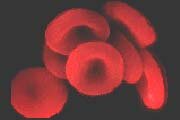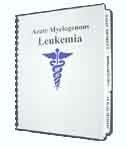 |
||
| HOME | ||
 |
||
| Acute Myelogenous Leukemia (AML) |
||
 |
||
| Other Leukemia Types (ALL / CLL / CML / HCL) |
||
 |
||
| Myelodysplastic Syndrome | ||
 |
||
| Symptoms and Diagnosis | ||
 |
||
| Leukemia Treatment Options | ||
 |
||
| " Chemotherapy | ||
 |
||
| " Blood Stem Cell Transplants | ||
 |
||
| " Radiation and Surgery | ||
 |
||
| " Chemo Side Effects | ||
 |
||
| " Clinical Trials Info | ||
 |
||
| " Coping with Leukemia | ||
 |
||
| " What to Ask Your Doctor | ||
 |
||
| Financial Assistance | ||
 |
||
| At Risk Jobs/Exposure | ||
 |
||
| Leukemia Resources | ||
 |
||
| Survivor's Story | ||
 |
||
| Leukemia News | ||
 |
||
|
Search for information:
|
||

|
Leukemia Cancer News - Return to Menu Testing 'smart drugs' on children with cancer By Amy Dockser Marcus, The Wall Street Journal May 31, 2005 - Smart drugs like Avastin, Tarceva and Gleevec are transforming the treatment of many cancers for adults, offering the hope of turning once-deadly tumors into a manageable, chronic disease. Now doctors are starting to test whether children will benefit from these drugs as well. There are an estimated 15 to 20 clinical trials in the works around the country where children with cancer are being given so-called smart drugs. Unlike standard chemotherapy agents, these drugs target only cancerous cells and leave normal cells alone. Most of the drugs are approved for use in adults to treat cancers that children rarely or never get, such as lung, breast and prostate cancers or certain forms of leukemia. But the belief is that the mechanism causing certain cancers to grow is similar, and that these drugs could be a less-toxic, more-effective, treatment for children. There are some concerns about treating children with these relatively new smart drugs. One of the oldest, Novartis's Gleevec, won Food and Drug Administration approval just in 2001, and little is known about the long-term effects. Also, some oncologists say the very way these drugs attack tumors, such as halting the formation of new blood vessels, may also inhibit children's growing bodies. Still, the National Cancer Institute and the Children's Oncology Group, a pediatric cancer-center consortium, are sponsoring trials at dozens of facilities around the country. The lung-cancer drug Tarceva is being tested in children with brain tumors. The colorectal-cancer drug Avastin is in trials with children who have neuroblastoma, a brain cancer, and Ewing's sarcoma, a bone cancer. And Gleevec, which first won approval in adults with gastrointestinal stromal tumors and chronic myelogenous leukemia, two diseases that are rarer in children, is now being tested in kids with a high-risk form of a common childhood leukemia, acute lymphoblastic leukemia. In addition, a number of smart drugs that have not yet won FDA approval are being tested in both children and adults -- including new compounds being developed by Genencor International Inc. for leukemias and lymphomas. The rising interest in smart drugs is being driven by a growing concern that progress in treating children with cancer has stalled. Survival rates for children increased to 78.6 percent in the 1995-2001 period, from 55.9 percent in the mid-1970s, according to the NCI -- an overall survival rate that is still much better than that of adults. (Of adults diagnosed with cancer today, 64 percent will be alive five years later.) But childhood mortality rates have flattened out in recent years. Most of the drugs used to treat children with cancer have been around for several decades, and while they are extremely effective, around 20 percent-25 percent of children do not respond to them. "The current treatments have essentially given us all that they can in terms of the ability to cure more children," says Malcolm A. Smith, associate branch chief of pediatrics at the NCI, which is part of the National Institutes of Health. "We need new approaches." Drug development for children's cancer has lagged far behind that of adults. When the FDA last year approved the chemotherapy agent Clolar -- co-marketed by Genzyme Corp. and Bioenvision Inc. -- for the treatment of pediatric leukemia, it was the first drug initially labeled for pediatric oncology in over a decade. In part that's because the market for children is much less lucrative for drug companies. "There are so few children, relatively, with cancer," notes Christopher Wood, CEO Of Bioenvision, which was able to take advantage of patent-related incentives from the FDA to pursue the pediatric approval. "It's awful when they get cancer," so such incentives are necessary to overcome some of the business obstacles that have led pharmaceutical makers to ignore the pediatric cancer-drug market. There has also been a concern that any problem that arises in children might derail the drug's use in adults as well. Moreover, there is real reluctance by some pharmaceutical companies to use very sick children in drug trials before enough is known about a drug's safety. Genentech Inc., which makes Avastin and co-markets Tarceva along with OSI Pharmaceuticals, is providing Avastin for limited, early-phase studies sponsored by the NCI. The trials are taking place at 21 institutions that are part of the Children's Oncology Group. Avastin works by inhibiting the formation of new blood vessels that feed tumors. But such blood vessels are "also important to normal growth and development," says Nikki Levy, a spokesperson for Genentech. "Before we embark on a broader, Phase 2 study of Avastin in children, we are trying to understand both the drug's safety and how it breaks down and interacts in a child's body." Diane Young, vice president of clinical development at Novartis Oncology, notes that it is important to get an understanding of a drug's safety profile and dosing requirements in adults before opening studies with children. For some families, the potential of smart drugs has already transformed the way they choose treatments for their children. When Kyle Conrad was diagnosed four years ago at age 12 with chronic myelogenous leukemia, the family considered a bone-marrow transplant, which is still the standard therapy for curing leukemia. Neither his parents nor his younger brother and sister were a match to be a donor. Kyle was put on chemotherapy while doctors searched for an unrelated donor, but the drugs made him feel sick. Then doctors suggested putting him on Gleevec, which had just been approved and was having remarkable results in adults with the same kind of leukemia. By September, after just two months on the drug, he felt well enough to start the seventh grade with his classmates. "You couldn't tell he was sick," says his father Kevin Conrad, an employee-benefits consultant from Columbus, Ohio. Later, when a potential donor was found, his parents weighed the risks of a transplant. The mortality rate can run anywhere from 10 percent to 45 percent, depending in part on how well-matched the donor is. Even if the transplant works, some people must live with terrible side effects, such as chronic graft-versus-host disease, which can cause diarrhea and rashes, and put the patient at risk of infections. Meanwhile, the side effects Kyle experienced with Gleevec -- mainly stomach upset -- were manageable, and the drug kept his leukemia in check. The Conrads decided to simply keep Kyle on Gleevec rather than try to cure the leukemia. Even after Kyle's leukemia levels began rising again last year, the family decided against a transplant. Doctors feared that his cancer had grown resistant to Gleevec, which often happens in adult patients. But after Kyle's dose was raised to 800 milligrams a day, his leukemia levels dropped again. Four years after his diagnosis, Kyle, now 16, still has leukemia but is living a normal life. "If he gets four or five more years on Gleevec, they're already working on new drugs. Our hope is that he could live a normal life span on these smart drugs," says Kristie Conrad, Kyle's mother. Pediatric oncologists are also trying to come up with ways to get the latest smart drugs into trials for children faster. Stephen Sallan, chief-of-staff at Dana-Farber Cancer Institute in Boston, is testing a Merck & Co. compound called MRK-5037 for a particular form of leukemia that has typically not had a good prognosis. More than half of patients of all ages who have T-cell acute lymphoblastic leukemia have a particular mutation in a gene. Because of this similarity, "it would be a terrible mistake to have the kids wait five years to see if the drug works in adults before trying it on them," says Dr. Sallan. Merck and Dr. Sallan's team made a deal: Once two adults are safely treated with a 28-day course of the drug, children will then be enrolled in the trial as well. "The science makes us recognize that the treatment is likely to be successful equally in children and in adults," says Stephen Friend, executive vice president for advanced technology and oncology at Merck. Since the trial started earlier this year, one adult has safely finished, a second didn't respond to the drug, and a third is about to enroll. Dr. Sallan is hopeful children will be eligible to join the trial soon. "We need to get away from thinking about using cancer drugs based on someone's age," says Dr. Sallan. "There is a lost generation of children out there."
|
|
|


